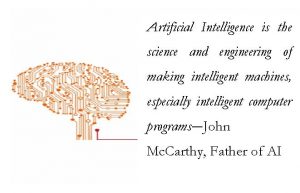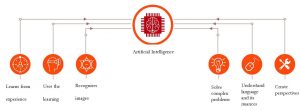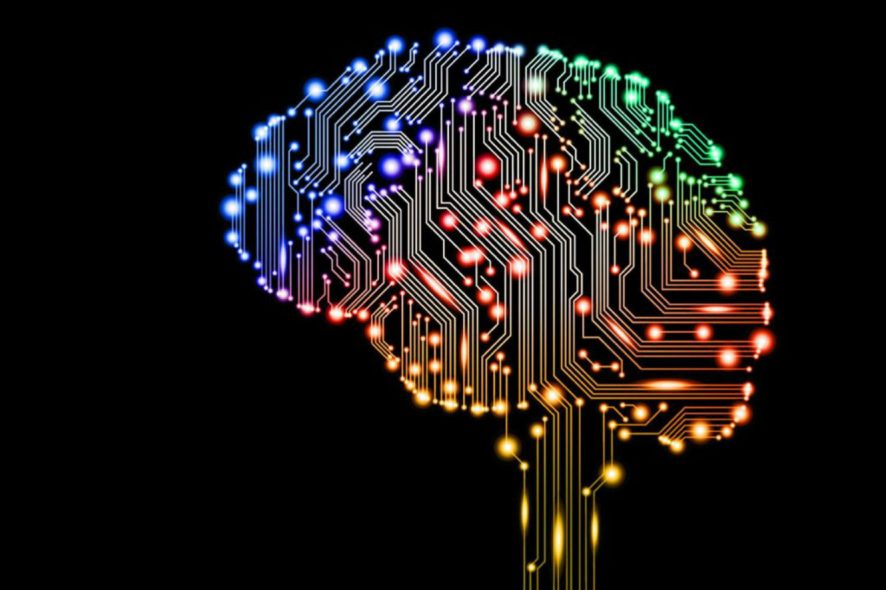Artificial Intelligence (AI) is not a new concept, especially to the readers of science fiction. In recent times however, it is becoming more science and less fiction. The world of technology is changing rapidly, and Artificial Intelligence systems have been gaining widespread momentum. With sophisticated technologies being incorporated in the same, it is only a matter of time these systems start to produce marvellous inventions without human intervention of any kind. AI, simply put, is the capability of a machine to imitate intelligent behaviour. It is an umbrella term that refers to information systems inspired by biological systems, and encompasses multiple technologies including machine learning, deep learning, computer vision, natural language processing (NLP) machine reasoning, and strong AI.[1]
Most definitions of Artificial Intelligence in the standard texts are overly complex for a general survey of the field, so here is a simple one that will suffice instead: Artificial Intelligence is the science of mimicking human mental faculties in a computer.
Modern definitions:
Artificial Intelligence refers to the ability of a computer or a computer-enabled robotic system to process information and produce outcomes in a manner similar to the thought process of humans in learning, decision-making and solving problems.

Figure 1[2]
Artificial Intelligence and IP law
The intellectual property (IP) industry is the most noteworthy market where AI could have a profound effect. With the clear visibility of remarkable extent of creativity and knowledge exhibited by AI, concerns pertaining to IP protection ought to be there in the minds of those enforcing the rights associated with the intellectual property. On this it is required to go on to the more deliberative end of the copyright debate in connection with AI solutions and the relation of patent laws with AI systems.
A draft report of the European Parliament to the Commission on Civil Law Rules on Robotics[3] mentions that in the future, AI will leave no stratum of the society untouched and also calls on the Commission to elaborate criteria for an “own intellectual creation” for copyrightable works produced through AI. Now, there are machines which automatically create works which would qualify for a copyright protection, if it were produced by a human. There have been several high degree computational creative innovations until now and this has sparked debates all over the world for the re-examination of copyright standards for AIs. Recently, a San Francisco Court denied a copyright to a macaque monkey who clicked selfies which went viral. With copyrights for animals out of the picture now, a similar situation has arisen for AIs. Recently, many copyright offices across the world have already mentioned that they would not register machine produced works. Similarly, under patent law, if novel inventions are made by AI machines, issues may arise regarding the ownership of such inventions. Without any human intervention, who will own the patents on novel inventions filed by AI machines? Will the machine/robot be the owner of future inventions? When ownership rights are distributed amongst different entities, who will be able to enforce such rights. And if an AI plagiarises a creation or reproduces an invention, how will damages be determined? These are a few basic but puzzling questions which patent laws now face.[4] With the monumental growth of AIs in every industry of the market, it is incumbent upon IP theorists and lawmakers to design laws which can be adopted in a world with AIs.[5]
Position in India
There is a wide variety of intellectual property legislations which would impact/affect the functioning of AI in India. Such legislations are discussed in detail below.
A. Copyright
Indian Copyright law requires that in order for a “work” to qualify for copyright protection, it would firstly have to meet the “modicum of creativity” standard laid down in Eastern Book Co. v. D.B. Modak[6]. From a reading of the test laid down in the aforementioned judgment however, there is no definitive conclusion that may have arrived at wherein it may be stated that an AI cannot meet the “modicum of creativity” as required.
In addition to the above, the second requirement to be satisfied by an AI when it comes to the ownership of copyrighted works is the requirement to fall under the aegis of an “author” as is defined under the Copyright Act, 1957. This would be problematic as an AI has generally been regarded to not have a legal personality. Under Section 2(d) of the Copyright Act, 1957:
2.(d) “author” means,—
(vi) in relation to any literary, dramatic, musical or artistic work which is computer-generated, the person who causes the work to be created;”
The first issue under the above mentioned definition is its usage of the terms “the person who causes the work to be created”. Determining who “causes” a work to be created is a question of the proximity of a natural or legal person to the creation of the “expression” in the content in question — the more closely or directly a person is involved in creating the “expression”, the more he or she contributes to it, and the more likely he or she is to qualify as a person “who causes the work to be created”. As a result of the above, the current legal framework under the Copyright Act, 1957 may not effectively deal with/prescribe for creation of works where the actual creator or a contributor of the “expression” is not a human or a legal person. Thus, when it comes to works that are created by AI, their authorship would be contentious under Indian copyright laws.[7]
B. Patents
Section 6 of the Patents Act, 1970 states that an application for a patent for any invention can be made only by the true and first inventor of the invention or the persons provided upon request only assigned by such person. Whereas, Section 2(y) of the Act confines the definition of “true and first inventor” to the extent of excluding the first importer of an invention into India, or a person to whom an invention is first communicated outside India, and nothing further. These provisions do not expressly impose the requirement of an inventor to be a natural person. Therefore, from a bare reading of these provisions, it may be interpreted that an AI may fall under the definition of an inventor as provided in Section 2(y) of the Patents Act, 1970. However, in practice the “true and first inventor” is always assumed to be a natural person. Thus, it will be interesting to track the jurisprudence on this front especially the stand taken by the patent office when the “true and first inventor” on the patent application form is not a natural person. However, AI will certainly play an important role in the evolution of patent law itself. Sophisticated use of natural language processing has been adopted in generating variants of existing patent claims so as to enlarge the invention’s scope. The publication of these patent claims using such technology would help preclude obvious and easily derived ideas from being patented as they will form the corpus of the prior art that is available in public domain. If the trend of using such services gains a foothold in the industry, it will substantially increase the uncertainty associated with the enforceability of a patent as the risk of not discovering prior art that invalidates the patent would increase. As a result, it could be anticipated that AI would be developed to assist in discovery of prior art and correspondingly this would certainly increase the demand of AI (from a patent law perspective) in this sector.[8]
AI and IP law: A way frontward
With decades of R&D, IBM’s AI engine Watson, is now capable of detecting a type of cancer in just 10 minutes and this once helped save a person’s life. It was said that the same would have gone undetected under conventional diagnosis methods. From autocorrecting our text messages to saving people’s lives, AI has only begun influencing our lives in a great way. But IP laws are far from matching the progress being made in AIs. Currently IP law focusses only on human actors as IP creators/infringers. It is time now, for policymakers to come up with standards and liability criteria when it comes to IP surrounding AIs. It will also be interesting to see how IP sharing works in the AI realm. It is also believed that the future of many industries depend on AIs and therefore, IP sharing will be a crucial aspect of the overall development agenda and sustainability. The AIs will slowly become a part of every imaginable industry and even though the European Commission has taken baby steps in raising questions over IP laws for AIs, the future is full of intriguing prospects for innovators and businessmen, alike.
Conclusion
The penetration of self-driven cars, robots and fully-automated machines, which are currently being used in various economies around the world, is only expected to increase with the passage of time. As a result, the dependency of entities and individuals on AI systems is also expected to increase proportionately. Whilst addressing the position of Artificial Intelligence, it would be imperative that the regulators undertake a reasonable and balanced approach. A positive step towards the recognition of AIs could be that, all member countries of multilateral trading forums begin to recognise the same, for instance, in the form of an amendment to Trips. The AIs today perform human like functions in every sphere. It would not be amusing if, tomorrow they can perform functions better than humans and take their decisions themselves. To keep a track of the same, a legislation governing AIs should be drafted, to provide for guidance/clarity as to the rights and obligations of programmers or creators of AI systems, in order to crystallise the broad ethical standards to which they are required to abide to whilst programming/creating AI and robotics systems. Due to the lack of legal jurisprudence on this subject, it is hoped that in the near future legal and tax principles are established which will not only foster the development of AI but also ensure that the necessary safeguards are in place.
* Vaishali Singh is Research Associate, GNLU-Microsoft IPR Chair, Gujarat National Law University.
[1] Raquel Acosta, Artificial Intelligence and Authorship Rights, Harvard Journal of Law and Technology (17-2-2012), available at: <http://jolt.law.harvard.edu/digest/copyright/artificial-intelligence-and-authorship-rights>.
[2] PWC analysis, available at <https://www.pwc.in/publications/2017/artificial-intelligence-and-robotics-2017.html>.
[3] See <http://www.europarl.europa.eu/RegData/etudes/ATAG/2017/599250/EPRS_ATA(2017)599250_EN.pdf>.
[4] Mailer, Artificial Intelligence & Intellectual Property Rights, October 2016 available at <www.clairvolex.com>.
[5] R. Kurzweil, The Age of Intelligent Machines, 272-275 (MIT Press: 1990).
[7] Final Report of the National Commission on New Technological Uses of Copyrighted Works 4 (1978), available at <http://eric.ed.govPDFS/ED160122.pdf>.
[8] Office Order No. 36(2017), Intellectual Property Office (India), <http://www.ipindia.nic.in/writereaddata/Portal/Images/pdf/Office_Order_No_36_of_2017_for_Revised__Guidelines_for_Examination_of_CRIs.pdf>; Balaji Subramanian, Patent Office Reboots CRI Guidelines Yet Again: Removes “novel Hardware” Requirement, SpicyIP, <https://spicyip.com/2017/07/patent-office-reboots-cri-guidelines-yet-again-removes-novel-hardware-requirement.html>.







A patentability search focusses on identifying prior art references essential in understanding if the invention meets the requirements of novelty and non-obviousness in the light of prior art. Also, patentability search helps in determining the scope of patent protection to be sought while drafting a patent application. An effective patentability search assists a drafter to understand how to design around claims of the invention to avoid rejections.